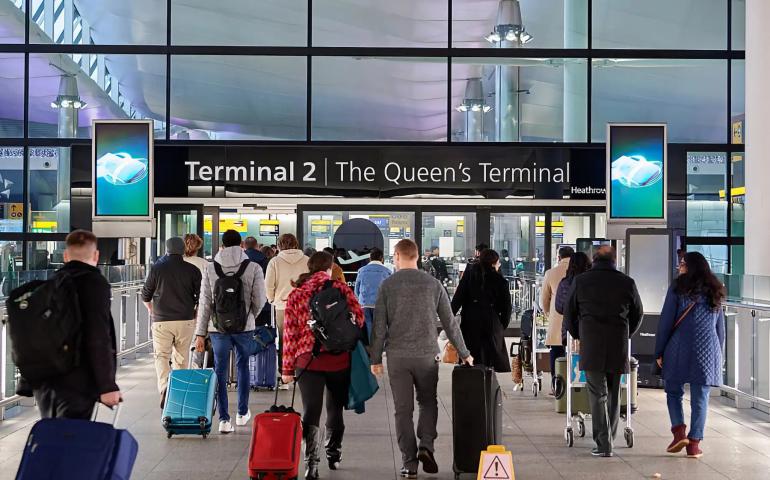
Electric powered aircraft are close to being integrated into the global aviation ecosystem. Thanks to the progress in technology, small electric airplanes are already a reality, and it is expected that these airplanes will be the first step towards the constitution of fully electric fleets in the market for short-haul air taxis, that encompass between 200 and 500 nautical miles routes.
Eliot Lees is Vice President and Managing Director of Clean Transportation at specialized digital services and consulting firm ICF*. He specializes in diligence, valuation, business planning and development of aviation infrastructure and is an expert in airport projects, air cargo, aircraft maintenance, logistics centers, commercial / industrial parks, aerospace manufacturing and fueling, among other areas.
In this interview with A21, Eliot addresses some aspects of the current panorama of electric aviation, the challenges and opportunities that exist for this type of aircraft. The time has come for these vehicles and there is a huge market for them.
- What is the main challenge for electric aviation?
The main challenge is getting the electricity to the aircraft, or the charging infrastructure that will be needed for the aircraft. The technology is there, there will be electric aircraft that will be certified in the next 2 to 3 years, but to operate the aircraft you need a whole new fuel propulsion system, which means a new way of getting power to the aircraft. It is not fuel anymore, and a lot of airports are not prepared to support the charging infrastructure that will be required.
- What do airports need to support the electrification of aviation? What kind of infrastructure needs to be available for those things to happen?
The four questions that you need to address as an airport to figure out the electrical charging infrastructure are: What do you need? When do you need it? Who is going to operate it? and, Who is going to pay for it? Those questions are challenging to the airports because, unless the government is trying to install infrastructure in advance, and without any sort of business payback structure related to it, there are going to be challenges with early adopters. Operators might not be able to collect enough to pay for the charging stations or getting the power grid to the airports and the power infrastructure that is going to be needed to support electric aviation, and that is one of the biggest challenges for electric aviation in Latin America. It is unclear today, the timing in the phasing of the operation, and yet to make it happen someone must make the investment.
Various electric aircraft OEMs are using different approaches. One of our clients is installing charging stations along networks, that their customers are going to use. It is the same concept of automobile companies building the gas stations a 100 years ago, it is the same idea. There are some private initiatives going on, but in the early years, it is not going to pay for itself.
- How do you see the general development of electrical aviation in Latin America, despite what you have said that there are no government or private initiative funding it currently?
If we look at what the opportunities are for electric Vertical Take-Off and Landing (eVTOL), largely at first, they will be the replacement of helicopters, and what are the 3 largest markets in Latin America for helicopters? São Paulo in Brasil, Mexico City and Guatemala, that is really where the opportunities for eVTOL are in the near term. In terms of electric aviation I consider that this will be transformational for Latin America, because one of the greatest challenges of Latin America has always been that the demand or the markets were big enough to support narrowbody jets service, and what electric aviation is promising is a more distributed aviation or regional aviation mobility, basically it allows that it does not need to fill 100 seat aircraft to make air travel work, it can be done in much smaller aircraft and therefore, the market economics of aviation change. Latin America and the Caribbean are markets that have always been challenging, because the size of the market is not big enough to support the large aircraft service, and this is going to increase the demand, lower costs to end users, and provide better transportation services and more sustainable transportation services than we had in the past.
The cost to build and maintain a highway is substantially greater in terms of the economic footprint than flying the same volume of passengers between point to point.
- In that sense, do you see that there is a great opportunity for Latin American governments to really invest into this kind of technology to address the issues that have historically been here in the region for many years? Do you see political willingness to do that?
It is too early to tell. The question today is, what technology to invest in? Should you be an early adopter and invest in electric aviation, and that means smaller aircraft, or should you wait for hydrogen and hydrogen fuel cells to become viable and then you have a different set of infrastructure requirements? or should you be focused on sustainable aviation fuel replacing large aircraft? Should you as a government invest in the technologies or encourage the technologies that are behind sustainable aviation fuel? Those are the really the 3 bets that governments should make. In the electric segment of the market, that is probably 3 years away from commercial introduction, but 5 years or more away from widespread adoption. Then you have hydrogen, which is further out and then you have a sustainable aviation fuel which is going on today. They are not mutually exclusive, but governments need to think about which of these technologies they want to invest in, and what is the overall benefit to the end user and reducing a Nation's carbon footprint.
- Of these 3 types of technologies, which one is the cleanest?
That is a very difficult question. I think the answer to that question is: Where does the power come from? It takes energy to do all 3, and electric aviation is direct power, but the direct power must be produced. One of the challenges we are working on in Hawaii, which will be one of the early adopter markets for electric aviation, yet currently they are producing power using fossil fuel, so you don’t have clean power going into the aircraft. However, there are some benefits, some carbon reductions from doing that, yet that is not the end-result you would like to have renewable energy supporting electric aviation. Hydrogen requires a significant amount of electricity to convert to a usable form, and the same thing with SAF, there is energy that must go into the conversion of whatever feedstock will be used to convert to jet fuel. So, theoretically, electric aviation is probably the cleanest, although hydrogen has the potential to be the cleanest, if they can figure out the technology to go from direct hydrogen to power.
- So electric aircraft are coming in the next 2 to 3 years, they are going to be regional, they will not be long haul. When do you believe that the technology could evolve enough to allow long hours flights?
It is all about battery technology and how that is going to be progressing. As far as I know, we are probably looking at the next 10 years to get to a point where there are batteries that will be sufficient to support the sized aircraft for the length of time that will require a long-haul route. What we see today, the OEMs that are building out aircraft, are looking to one hour to two, or 2 and a half hours of flight time, about 500 nautical miles is the range of these aircraft. Given that they are 9 seat aircraft, that is largely the range of that market, and so there could be real growth in the short haul, 200 to 400 mile market that will take an hour to one hour and a half, and that technology is really here today. The size of the aircraft is a different story, but the range of the aircraft with a 9-seat requirement, which is what will happen in the U. S. first, it is going to be the leading edge of electric aviation and, in 2024 we will see more than 1 operator going from type certification to commercial proving out.
- Okay so from your point of view, which electric aircraft project at the moment do you think is the most promising?
There is a company called Beta Technologies which has a eVTOL aircraft, and they are currently flying under FAA experimental licenses. They have done a 200 miles test flight on their aircraft and they are part of the Air Force Agility Prime Program. The Air Force has selected two operators under this program, Beta Technologies and Joby Aviation, and they have provided initial funding, and they are currently doing piloted trials with Beta and non-piloted trials with Joby, so both of those operators are operating under FAA experimental licenses. Those are 2 of the most promising to come into the market first.
There is a third company called Ampaire. Those 3 are operating under FAA experimental licenses, they are under the certification process, but no one else is flying under this experimental license.
- How is NASA helping with the development of all these new technologies?
They are doing studies and they are coordinating with various stakeholders to try to think through the various problems that need to be addressed. One of them is the structure, another one is air traffic control, particularly for an eVTOL aircraft, or the certification process, so NASA is trying to encourage and provide the framework for the industry to think about and address some of the key problems that need to be overcome in electric aviation. They are not giving money out to operators or to others to design and to install, however they have a framework or protocol in all the things that must be addressed to launch electric aviation. Yet they are funding working groups to study and provide recommendations and guidance to the industry on how to address these challenges.
The exciting part of electric aviation is the benefits that it can bring. From the economic benefits to the end user. If electric aviation happens, the way that we envision, it is going to change the industry in a way that has not happened since the age of the launch of the jet, 70 years ago. So, and hopefully at a price that will broaden the ability of people to fly, and from that standpoint, we are really on the edge of the cost of something revolutionary, and in our industry, everything has been evolutionary, so this is exciting.
On the other side there are challenges in terms of new infrastructure, new certification process that must be thought through and very fast-moving technology, and that is a challenge for the industry in terms of how to pay for aircraft. It is like your phone, if the next version of your phone is 10 times better, suddenly, your current phone is going to be obsolete in 3 years, and this is not how the industry has functioned in the past, therefore the basic premises of how the industry works may be rethought in the next 5 to 10 years.
In summary, the idea is evolutionary in the industry by building infrastructure, paying for aircraft, on how airlines will operate, yet operators, investors and airports will need to change their business model. If the aircraft is revolutionary, there will be other segments of the market that are going to be transformed.
- What is going to happen in Mexico?
I am looking mainly at Mexico City. I have spent a lot of time looking on how Toluca Airport was built as a secondary airport to Mexico City to serve the western “colonias” of Mexico City. What if we do not need Toluca, what if we need parking lots, rooftop garages where people will be flying out of? Those are some very interesting concepts that could change how we get from one side of the city to the other. What if you want to go to the airport, and you can take a small aircraft and fly from the top of a parking garage in the western part of the city, or in the southern part of the city and fly to the Mexico City airport.
In the case of Mexico City, the challenges of ground transportation including building new roads or building new trains is too expensive. This is an opportunity for Mexico City to leapfrog for the transportation industry, because there are challenges of getting from point A to point B. Maybe it's not eVTOL immediately, because it also presents challenges, for example, all flying in the same space around Mexico City. It can be difficult to understand how that can work, but certainly the short take-off and landing type of vehicles that will land on 30 to 50 meters, could be on a parking lot for a shopping mall or the top of a parking garage to go from one side of the city to the other. I see that happening in the next 10 years.
I've been working in Mexico for 30 years and we're still no closer to it and so, how do you maximize what you have? You maximize what you have by taking a portion of the traffic, the short haul segment of the traffic, the regional segment of the traffic and changing how it is going to work. And again, linkages between various parts of Mexico City and the existing airports. That is what the near-term future of this transformation in aviation is going to be. It's time and it's a huge market.





Facebook comments